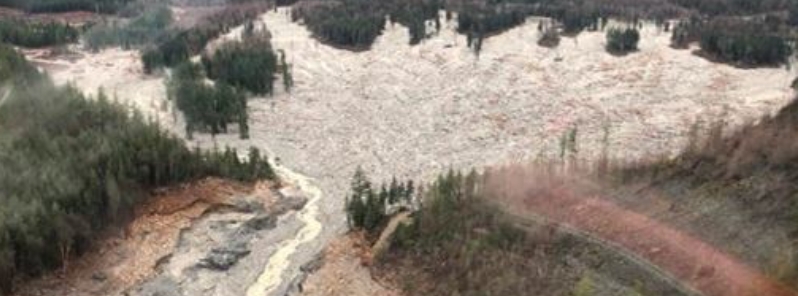Massive landslide causes major destruction to wildlife in Bute Inlet – British Columbia, Canada

A massive landslide hit Bute inlet in British Columbia, triggering a wave of debris that caused a lot of destruction to the forest, wiping out critical habitat for many animals, and causing hazards for marine traffic in the area, according to a helicopter survey of the site on December 14, 2020. The landslide is believed to had happened in late November, following heavy rains that struck the region.
"It has destroyed a lot of the forest, and there [are] lots and lots of flooding everywhere in the valley and the inlet," said helicopter pilot Bastian Fleury after surveying the affected region, along the 12 km (7.5 miles) slide down the Southgate River.
The landslide pushed trees, rocks, and mud into Bute Inlet. "It has completely changed the course of the Southgate River," Fleury added.
It appears that a block of glacier crashed into a lake in the upper reaches of the watershed, leading to a cascade to descend down the valley. Fleury said the landslide likely occurred after heavy rains in late November.
"It's got to be very bad for all the wildlife in the area," he noted, as the slide has destroyed significant habitat for many animals. The Southgate River is a refuge to many animal populations such as salmon, grizzly bears, bobcats, and elk.
"We were impressed by the force of mother nature, but there’s not much we can do about it."
The event caused a considerable environmental impact, with debris posing dangers for marine traffic off the Vancouver Island's northeast coast, according to Strathcona Regional District director Jim Abram.
"The scouring of that valley seen in the footage is incredible," said Abram. "Imagine that amount of material out of the canyon has flowed down to Bute Inlet and the debris is continuing out to the ocean."
"Wilderness tourism is a big part of our economy, and it’s just taken a big hit from Mother Nature."
In an analysis by Dr. Dave Petley of The Landslide Blog, he pointed out that a very large failure occurred on the rock slope to the west of the front of the glacier.
The very large mass infiltrated the lake, driving a massive displacement wave that entered both the water and lake sediment to form "a catastrophic debris flow," he described, down the valley.
Satellite compilation from Marten Geertsema FLINRO (@geertsegort) hopefully we can get clearer images later. Lidar would be nice @brianmenounos ! There is likely pre-event lidar pic.twitter.com/bt9NrwCh8C
— Brent Ward (@GeoBrentatlarge) December 12, 2020
Sentinel-1 SAR shows that it happened between Nov 26 and 30 pic.twitter.com/kvpCn4TxN6
— Simon Gascoin (@sgascoin) December 12, 2020
"This is a classic compound hazard chain– landslide, displacement wave, debris flow, debris flood, and possibly even a submarine density flow in Bute Inlet."
"Detailed analysis of this event may need to wait until the Spring, but good data should be available from the regional seismic network, which should yield data on the timing, volume, and velocity of the event," he added.
"It is very interesting that this large failure occurred very close to the snout of a retreating glacier."
Featured image credit: Brent Ward

Commenting rules and guidelines
We value the thoughts and opinions of our readers and welcome healthy discussions on our website. In order to maintain a respectful and positive community, we ask that all commenters follow these rules:
We reserve the right to remove any comments that violate these rules. By commenting on our website, you agree to abide by these guidelines. Thank you for helping to create a positive and welcoming environment for all.